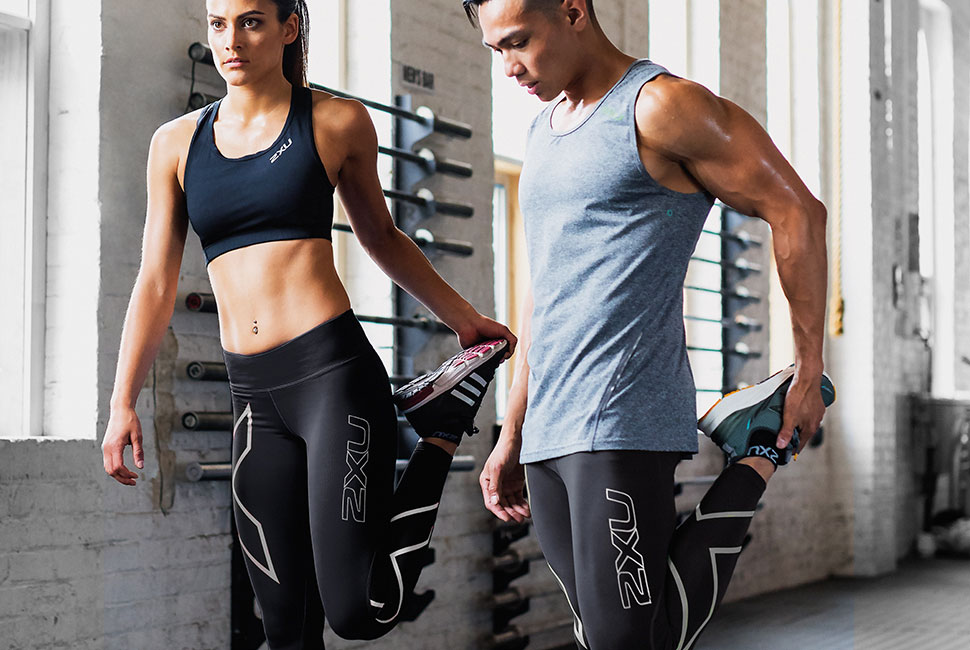
Compression wear – from the average gym goer and weekend runner, to the professional athlete. No doubt you’ve seen compression garments being worn plenty of times before. But how effective is compression wear for the non athlete? Is it just a fashion fad or is it a legitimate option for increased performance and recovery? We sat down with Australian Olympic team physio and runner Myles Burfield to discuss.
1. Are compression garments necessary for increased performance and recovery?
At the amateur level compression garments are not necessary, although they could be beneficial depending on your reasons for using them. From a recovery perspective their use is well supported in the research, and they’re used widely within the elite community for travel and improved speed of recovery post high intensity sessions. Their performance benefits are a little more controversial. Some very weak research suggests that their may be some performance benefits across a few different sports (cyclists, netballers, track athletes) although the size of the studies were small, and the improvements were not ‘statistically significant’. This means that they found small changes but after analysis it was not clear if these changes are due to true benefits from compression garments, or just natural differences between the groups (aka sampling error).
2. Are they relevant for the casual/semi casual runner, or only for professionals?
In all honesty, if you’re looking for performance benefits as a casual runner you’re unlikely to find them in your compression garments. Although one of the biggest issues for amateur athletes is they often don’t have the time or resources to do optimal recovery (massage, stretching, proper cool downs). Compression garments can really assist when used after long or hard training sessions, or especially when you are training on consecutive days. A good example for many runners would be racing on a Saturday, and then doing a long run Sunday.
3. In terms of recovery, when is the most optimal time to wear compression garments and for how long?
For recovery compression has been shown to work best when worn within 1 hour of exercising, and kept on overnight. If they are used during exercise benefits have been shown as early as 15minutes post exercise (decreased blood lactate levels in athletes wearing compression), although if you have been exercising without the garments then the priority is to cool your internal body temperature first (water immersion, rest, drinking cool water) before applying compression garments which could make it more difficult to get your body temperature down.
4. From your experience through the AIS, which brand of compression wear did you find the most effective?
The battle of the brands is mainly between 2XU and Skins, and unsurprisingly they have funded much of the research. The bottom line is that more compression gives you more benefits in circulation, although it is often less comfortable to wear for long periods. There are different levels of compression. These are measured in millimetres of mercury (mmHg). The higher the mmHg, the higher the compression:
8-15 mmHg = mild compression.
15-20 mmHg = moderate compression
20-30 mmHg = firm compression
30-40 mmHg = Extra firm compression
When choosing compression garments for sporting or everyday use I usually recommend moderate compression, and choosing the brand that is the most comfortable. If the garment is a good fit, and compression is applied evenly, it should feel comfortable and non-restrictive. We want increased circulation, rather than circulation blocks.
Myles Burfield was an Australian Olympic team physiotherapist at the Rio Olympics, and is also a director at Activate Health and Fitness. Myles is part of JS-PT’s network of health professionals who works with us and our clients for specialised physiotherapy needs.
 Recent studies have questioned the effectiveness of static stretching for performance and flexibility – do you believe this to be accurate and does static stretching still have a place in a runner’s program?
Recent studies have questioned the effectiveness of static stretching for performance and flexibility – do you believe this to be accurate and does static stretching still have a place in a runner’s program?
For years there has been an ongoing debate about the effectiveness of static stretching as preparation for physical activity. The reason for this debate is that some studies have found benefit from static stretching, while some research suggests it may inhibit performance and increase the risk of injury. From my experience it is very dependant on the athlete, and the type of exercise they are planning to engage in. For runners there are key areas where flexibility is imperative, and if you do not have the range of motion in these areas then stretching can be very beneficial in both improving performance and reducing the risk of injury. A good place to start is by ensuring that you have enough ankle dorsiflexion, and hip extension. The images below show the basic tests for these movements. To maintain good running form it is recommended you maintain 10 degrees of hip extension availability, and you are able to achieve 13cm on your ankle dorsiflexion knee to wall test.


How important is strength training for a long distance runner?
Strength is arguably more important than stretching when it comes to running. The forces going through your joints are 250% of your body weight when you jog, and even higher (>400%) when sprinting. To be able to withstand these forces you need a combination of foot, ankle, knee, hip, and core strength. The research suggests that “30-50% of runners will suffer an injury over the course of 12 months”, this is a scary statistic, and the main cause is a lack of running related strength. The 2 best ways to work on your running related strength is:
- Do specific gym exercises that focus on your running propulsion muscles (especially the claves)
- Build your running up slowly so that your body has time to adapt. Stick to the 10% rule and don’t increase you total weekly kilometres by >10% each week
How do you know when to prioritise strength or mobility/stretching?
“A tight muscle is a weak muscle” and for runners the need to stretch often implies as need to strengthen. The easiest way to know if an area needs strengthening is to do some strength tests with a trainer or physiotherapist, but for an easy test at home you should be able to do 30x single leg calf raises on each leg, with no rest. This is the minimum strength to be safe to run 5km regularly (>3 times a week). If your hip extension or ankle mobility are poor then the priority is to stretch these, and restore mobility, before you run. If these areas continually get tight then it’s a strong suggestion that they may need strengthening.
Myles can be found at Activate Health and Fitness as well as at our home at The Fitness Specialists in Milton. Get in contact via myles@activatehf.com.au.
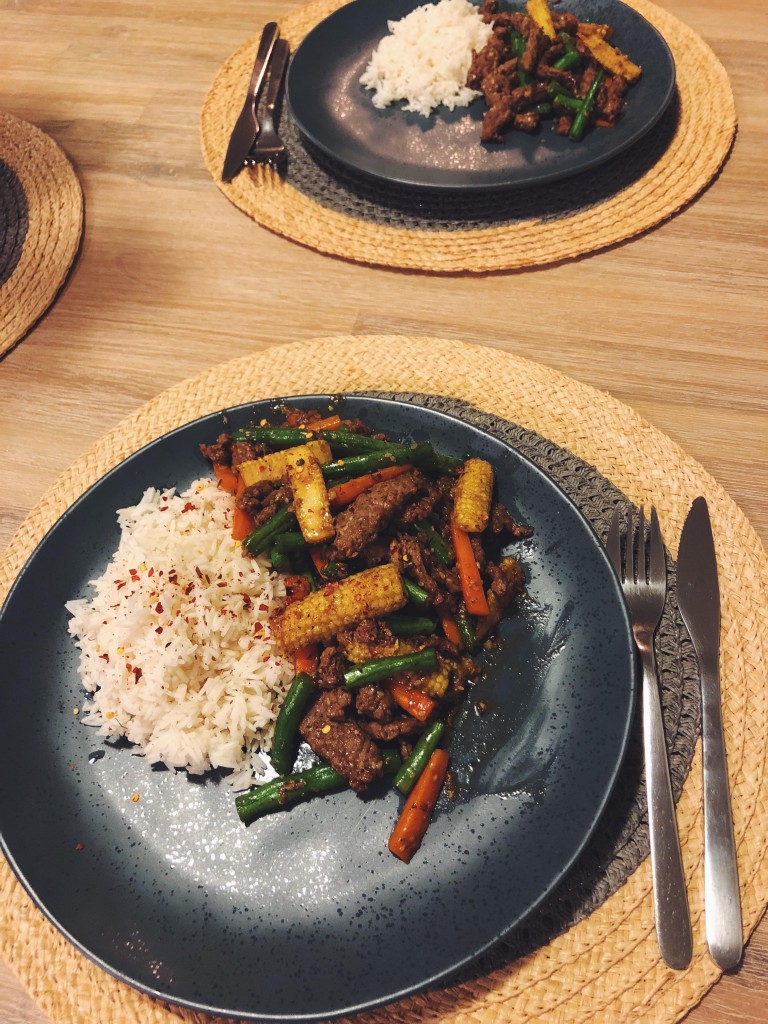
Processed with VSCO with f2 preset
We love a good stir fry as an option for a well balanced meal, and this beef sesame stir fry from taste.com.au was an absolute treat! Try it out.
Ingredients:
- 400g beef stir-fry strips
- 2 tablespoons sesame seeds
- 2 tablespoons vegetable oil
- 2 garlic cloves, chopped
- 2cm piece ginger, finely grated
- 1 carrot, peeled, cut into thin strips
- 115g baby corn, halved lengthways
- 150g green beans, trimmed
- 2 tablespoons Chang’s oyster sauce
- 2 tablespoons fish sauce
- 3 teaspoons caster sugar
- steamed jasmine rice, to serve
Method:
- Combine beef and sesame seeds in a bowl. Toss to coat.
- Heat a wok or frying pan over medium-high heat. Add 1 tablespoon of oil. Swirl to coat. Add half the beef mixture. Stir-fry for 1 to 2 minutes or until browned. Remove to a plate. Repeat with remaining beef mixture. Set aside. Add remaining oil, garlic and ginger to wok. Stir-fry for 1 minute or until aromatic. Add carrot, corn and beans. Stir-fry for 2 to 3 minutes or until vegetables are tender.
- Combine oyster sauce, fish sauce and sugar in a bowl. Stir until sugar is dissolved. Add to wok. Return beef mixture and any juices to wok. Stir-fry for a further 2 minutes or until beef is heated through. Serve with rice.
From taste.com.au.
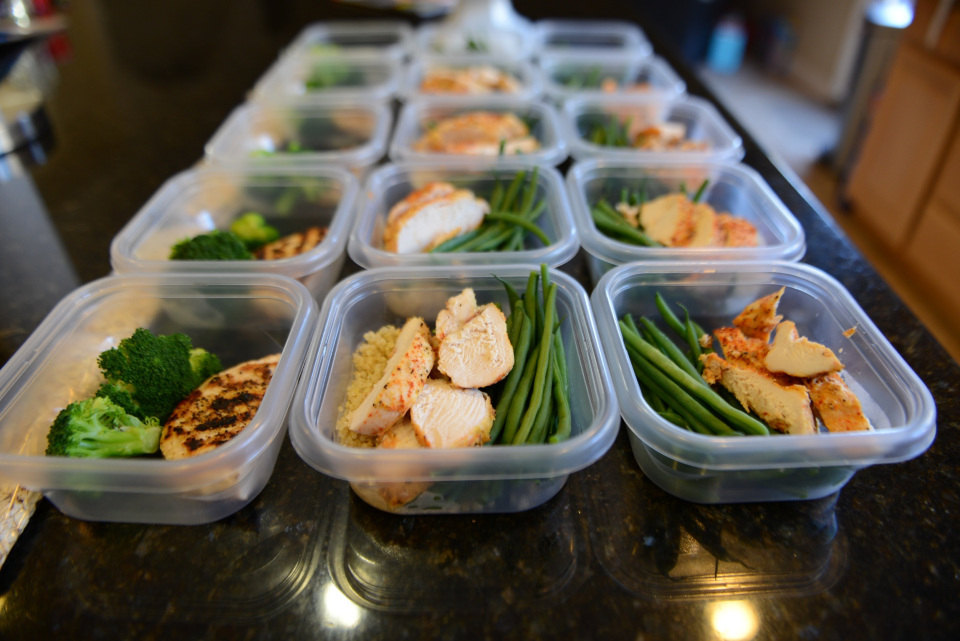
This month, we are excited to welcome back accredited dietician Serena Sullivan from Gather Nutrition. We were able to speak about food preps and kitchen staples, and whether or not preparing foods in advance was the only way forward in terms of improving one’s diet. Without further ado:
As a dietician, do you feel as though the practice of preparing food days in advance is the best way to ensure dietary compliance?
Personally, I am much more successful consuming a healthy, well rounded diet when I spend 20-30 minutes each night preparing meals/snacks as opposed to preparing them all in one go. I feel big batch cooking and a fridge full of tupperware containers can look and feel like ‘dieting’. Some people may be able to do that for a short period of time before they either become bored or they fall off the wagon due to not finding the amount of time required on a weekend.
Can cooking foods in bulk at times be a daunting prospect for someone trying to improve their eating habits?
In my experience, very much so. People can often find bulk prepping quite daunting. Many have good intentions when they set the goal of setting aside time on the weekend to do the planning, shopping, and preparing, but due to the hours this may take, it can be a challenge at times depending on the demands of family/social commitments and the like.
In saying that I have also seen clients who have made it a genuine part of their lifestyle and have sustained it for an extended period! It depends on what will suit your needs and what is a sustainable approach for ongoing success.
What are your favourite staple ingredients to include in your 20-30min prep each night?
My favourites to prepare at night will be a small container of full fat plain greek yoghurt and either a whole fresh piece of fruit or chopped fruit. I’ll always pack a variety of nuts and seeds which sometimes I’ll add to the yogurt or have separately. Its simple but you can’t go wrong with fruit and nuts. This makes for an easy snack throughout the day. I try to buy a few different types of fruit for the sake of variety.
I scale our dinner shopping to serve 4-5 people (only 2 people at home) so there is always left overs for lunches the next day. I’m always sure to have frozen vegetables, microwave rice, wholegrain bread, and some type of salad mixture, that way if dinner left overs are short on vegetables or a carbohydrate source, I can turn to these options to prepare a complete and substantial meal. Having the salad and wholegrain bread on hand usually means I will always have ingredients for a last minute salad sandwich with any vegetables if need be.
How do you ensure your clients are eating the correct portion sizes?
Whilst I educate my clients on serving sizes, I put more emphasis on making sure they are consuming enough food as opposed to food restriction. I put the biggest emphasis on the serving sizes of vegetables and try to encourage increasing vegetables servings. At the end of the day I want people looking at their meal and asking if they can see twice the amount of vegetables than they can see of protein or carbohydrates. If a meal is primarily vegetable based, it will always be nutritious and naturally lower in energy. Encouraging people to start thinking about increasing their vegetable intake (as well as increasing their intake of different varieties of vegetables) will mean they will naturally start to reduce in other areas where they may be over consuming.
I will however speak more specifically about carbohydrate serving sizes with clients who have particular health conditions, such as diabetes or insulin resistance. As a general rule of thumb, I try not too do too much food policing to give clients space to make changes on their own terms!
The Final Word with James:
Remember what may work for others is not necessarily the best option for you. Whether you are preparing your food days in advance in one hit, or doing a little preparation each night, the important thing is to have a plan of sorts. Write down some meals which you can cook, but be sure to pack your kitchen with some staples (think frozen vegetables, canned goods, microwaveable rice/couscous/quinoa, eggs, mixed leaf bags from the supermarket) incase your best intentions don’t come to fruition.
Follow Serena on Instagram @gathernutrition for more great tips!
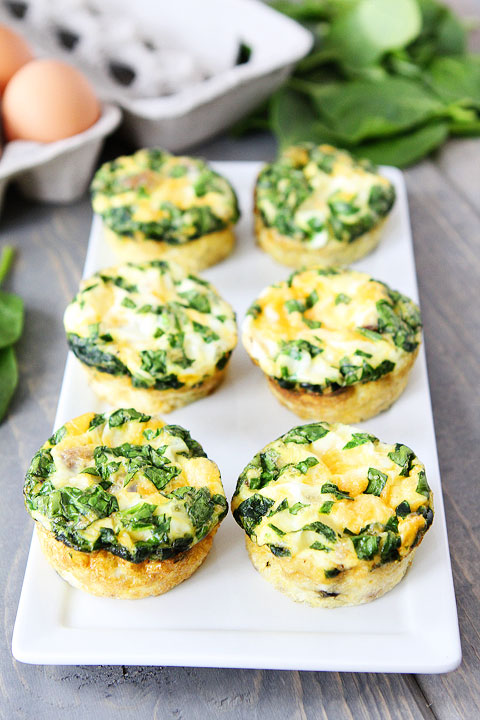
These mini frittatas baked in muffin trays make for a tasty breakfast/brunch option for your weekends at home, and can be reheated in the microwave. Garnish with herbs of your choice (parsley or chives for us) and season with some salt and pepper. Thanks to Two Peas and Their Pod for the idea!
Ingredients:
3 lean breakfast turkey sausage links
5 egg whites
Salt and pepper, to taste
1/4 cup freshly chopped spinach
1/4 cup shredded sharp cheddar cheese
Method:
Preheat the oven to 350 degrees F. In a medium skillet, brown the turkey sausage links on medium-high heat. Cook until sausage is brown all the way through. Cut sausage into 1/2 inch pieces. Set aside.
In a large mixing bowl, whisk together egg whites and eggs. Whisk in skim milk and season with salt and pepper, to taste. Stir in the chopped spinach.
Grease 6 muffin tin cups with cooking spray or line cups with paper liners. Pour egg mixture evenly into the muffin cups.
Distribute cheese and sausage equally between each muffin cup.
Bake egg muffins for 20 minutes, or until the muffins are firm in the center. Remove from oven and gently go round each egg with a butter knife. Serve warm.
Stay in shape this winter (and beyond) by incorporating some our favourites exercises we use in our programming. Some are conventional lifts, while others are variations on classics. Some will be more strength focused, while others will dial up your heart rate. Either way, start doing them now! Here we go:
1. The landmine clean and press.
An advanced full body movement focusing on power, The landmine clean and press is the perfect exercise to throw into a conditioning circuit given the amount of muscles you are working. The added rotational component makes this a go to of ours.
Once you’ve got the flow of the movement, it is actually much easier than it looks. Break it down by practising the following on the landmine attachment:
- Single arm high pull.
- .The pivoting of your feet by 90 degrees while changing the bar between your hands.
- A single arm press.
Note: A landmine exercise refers to an angled barbell movement where one end of the barbell is on the ground (either in an attachment such as above or safely wedged into a corner of a wall/something stable).
2. The forward to reverse lunge
With added volume compared to a traditional lunge, this variation targets the quads and glutes from two different angles, and really ups your heart rate! You don’t need to add much weight to feel this lunge variation in all it’s glory. Try to go from the forward direction to reverse without your foot touching the ground in between for balance. Regarding technique, practice the following:
- On the forward lunge, keep your spine in a straight line perpendicular with the ground.
- On the reverse lunge, hinge/tilt forward at the hips more while maintaining a straight back.
- Aim for at least 6 reps on each side (forward to reverse = 1 rep).
3. The trap bar deadlift
If you’ve been following us for a while you’ll know we love deadlifting and we will always recommend the movement, but in this case we are going to recommend the trap bar variation over the barbell for a number of reasons.
Both the barbell and trap bar deadlift help to increase hip mobility and increase strength through the posterior chain (lower and upper back, glutes, hamstring muscles), however the trap bar has less of a load on your spine due the torso being more upright. It could be a good starting point if you lack control and stability through your lower back. The neutral grip positioning of your hands (palms facing towards your body) are also much easier in terms of shoulder stability.
4. Pull Ups
Executing a pull up from a full hanging position is one of the toughest upper body exercises you can do, and requires plenty of strength through your upper back muscles, shoulders, and biceps.
Brace the glutes, keep the core tight, and envision pulling the bar towards your chest. As fitness expert and strength coach Bret Contreas says, think of the pull up/chin up as a moving plank and keep a straight line from the shoulders to the knees throughout the movement. Vary your grips and hand spacing to help improve your performance.
Also, your lats (upper back muscles which run from your shoulders to your hips) are one of the primary muscles being used in a pull up, and are key muscles of your core so strengthening them can assist in improving your squat and deadlift.
5. Goblet Squats
A much more natural squat position in comparison to a front and back squat, the goblet squat should be the starting point for all weighted squats as it allows you to set a rigid spine and perfect the balance and movement of a squat. As well as a starting point, there are benefits to programming variations of the goblet squats for people of all levels.
The goblet squat will help you improve the upright torso position that is needed for more advanced exercises (such as cleans, front and back barbell squats, amongst others), as well as being a great exercise for the quads, core, and upper back. Due to the upright torso position, this also allows for less stress through your lower back.
James
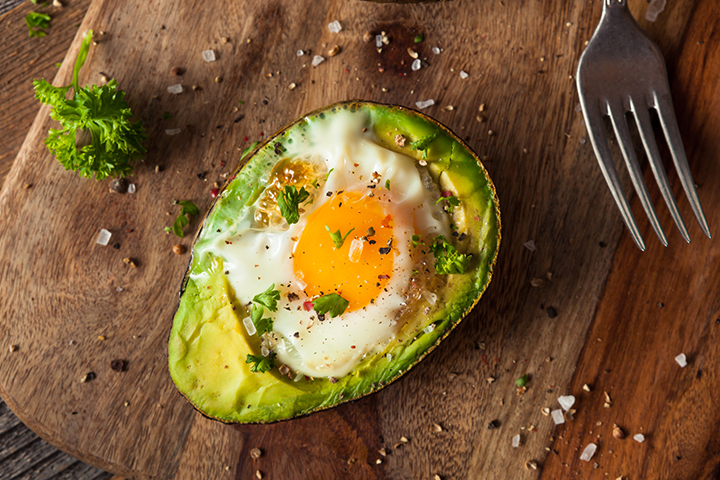
Start your day with an easy to prepare ‘protein and produce’ type breakfast, packed full of nutrients, and sugar free!
Ingredients:
- 6 avocados halved and seeded
- 6 large eggs
- salt and pepper, to taste
- 2 tablespoons chopped chives
Method:
- Preheat oven to 425 degrees F. Lightly oil a baking sheet or coat with nonstick spray.
- Using a spoon, scoop out about two tablespoons of avocado flesh, or more, as needed, creating a small well in the center of each avocado.
- Gently crack 1 egg, and slide it into the well, keeping the yolk intact. Repeat with remaining eggs; season with salt and pepper, to taste.
- Place into oven and bake until the egg whites have set but the yolks are still runny, about 15-18 minutes.
- Serve immediately, garnished with chives, if desired.
From https://damndelicious.net/2016/10/05/baked-eggs-in-avocado/
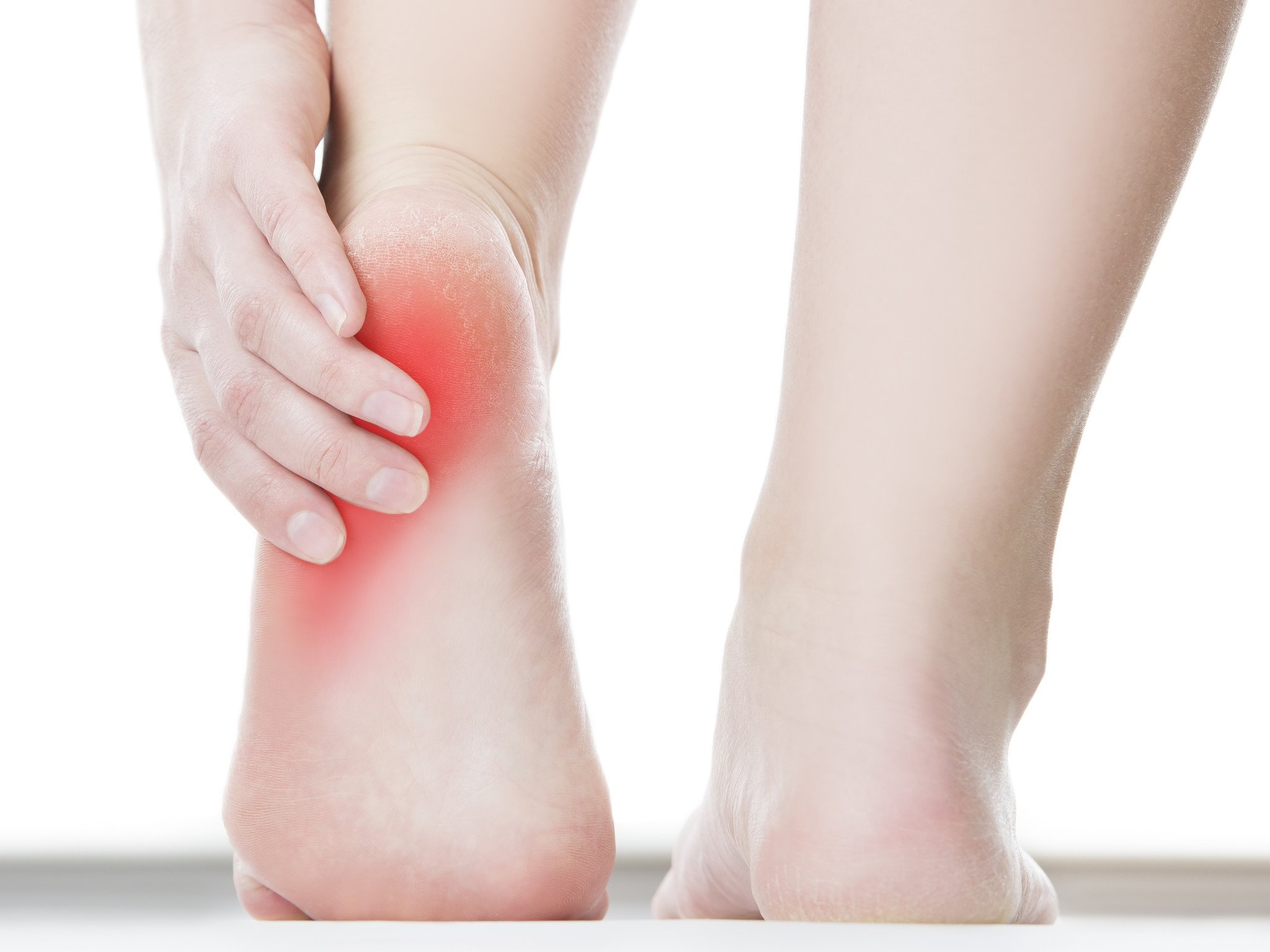
Hello again to the readers of the JS-PT Blog. I felt very honoured to be asked to write another article for you, this time delving into the all too common complaint of plantar fasciitis related heel pain (also referred to as fasciopathy, or fasciosis). In my 6+ years as a practising Podiatrist, I can confidently say that pain under the heel can be a very common issue with a number of possible causes, making it quite handy to have a professional on your side when it comes to treatment. With that in mind, this article, although not exhaustive, will hopefully give you a brief insight into this complex condition and provide some general information regarding treatment. Also, don’t forget to check out our video on the JS-PT Instagram on two quick ways you can directly mobilise the plantar fascia by way of massage and fascia release.
What is plantar fasciitis?
Plantar fasciitis is generally considered to be an overuse condition affecting the strong band of connective tissue (called the plantar fascia) that runs from the front of the heel to the ball of the foot. The role of the plantar fascia is to help to provide support when we’re up on our feet. Normally, the fascia is able to its job without any dramas however in some cases, overstretching and micro-trauma can occur, resulting in pain. This pain is often described by my patients as a sharp pain in the heel after rest (such as getting out of bed or after sitting/lying down), which then gradually dissipates as they “warm up”.
At this point, I think it is important to note that more than one diagnosis is possible for pain around the heel making adequate assessment from a health professional key.
How is it caused?
As plantar fasciitis is an overuse injury, it can theoretically be caused by anything that places excessive strain on the plantar fascia. As a result, common risk factors seen in practise are as follows (this list is not exhaustive):
- Increased BMI (body mass index)
- Poor foot and lower limb mechanics (such as having flat or high-arched feet)
- Wearing unsuitable footwear
- Occupation-related stresses (e.g. excessive periods of sitting or standing)
- Muscle tightness or imbalances
- Pregnancy
In addition, the onset of pain may correlate to a lifestyle change, such as new shoes or the alteration of a training program and exercise levels.
Can this affect the rest of my body?
You bet it can! As a lot of you would know, foot pain is incredibly frustrating as it affects us with every step. Our body, being the intuitive machine that it is, will try and avoid this pain by way of limping or altering its posture to reduce load from a particular structure (you may see where I’m going with this).
Prolonged foot pain can lead to compensatory action from other areas, changing your lower limb mechanics and possibly causing secondary pain in your ankles, shins, knees, hips, or lower back. It can also work the other way around. The cause of your heel pain can sometimes be due to something occurring higher up such as core and/or glute weakness, or misalignment of the lower leg – it’s a two-way street!
What about treatment?
There are a number of different treatment strategies available for plantar fasciitis. For example, some of the conservative treatment techniques available include:
- Rest and icing to manage symptoms
- Specially prescribed stretches
- Mobilisation and massage from a suitably qualified health professional
- At home self-treatments
- Strengthening exercises
- Certain strapping/taping techniques
This list is not exhaustive and some of the techniques above may be more suitable than others depending on the underlying cause. As a result, I would really like to emphasise that plantar fasciitis and heel pain can be complex in nature, with a variety of factors involved in its onset. This is why making an appointment with a Podiatrist is highly recommended as a more in-depth biomechanical assessment can be performed. This not only ensures that the correct diagnosis is made, but a suitable individualised treatment plan may be devised. Moreover, some people require additional support through an orthotic device to help improve function of the foot and lower leg.
For your health and wellbeing:
Remember, a person’s health and circumstances are unique. This information is general in nature and is not intended to replace individual professional advice or the opinion of your medical practitioner. Always seek the advice of a qualified health professional before making any decisions about your health.
Reference:
Brukner, P., & Khan, K. (2012). Clinical Sports Medicine (4th ed.). McGraw-Hill Professional Publishing.
Special thanks to Matt McKean and InStep Podiatry for the special guest blog. For specialist podiatry appointments, find them here.
For more information on training with the team at JS-PT, email us at info@js-pt.com.au.
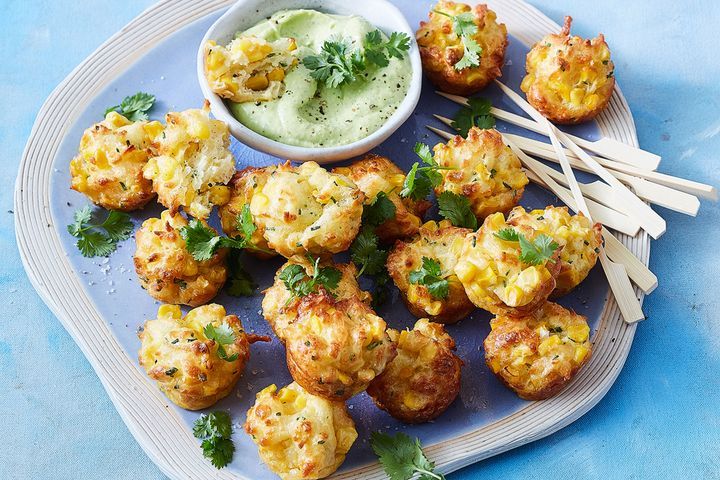
Ingredients:
- 225g block haloumi cheese, grated
- 420g can corn kernels, drained, rinsed
- 2 eggs
- 1/3 cup self-raising flour
- 1 teaspoon finely grated lemon rind
- 2 tablespoons chopped fresh chives
- 1 avocado, chopped
- 1/4 cup plain Greek-style yoghurt
- 1 tablespoon lemon juice
- 2 tablespoons chopped fresh coriander leaves, plus extra leaves to serve
- 1 teaspoon garlic powder
Method:
- Preheat oven to 220C/200C fan-forced. Place 1/2 teaspoon oil in each hole of a 24-hole (1 1/2-tablespoon-capacity) mini muffin pan. Place in oven for 5 minutes to heat up.
- Meanwhile, combine haloumi, corn, egg, flour, lemon rind and chives in a bowl.
- Divide mixture among prepared holes. Bake for 10 to 12 minutes or until golden and crisp. Stand in pans for 2 minutes. Turn out onto a wire rack.
- Meanwhile, process avocado, yoghurt, lemon juice, coriander and garlic powder until smooth.
- Sprinkle bites with extra coriander. Serve with avocado dip.
Thanks to taste.com.au – original page is here.
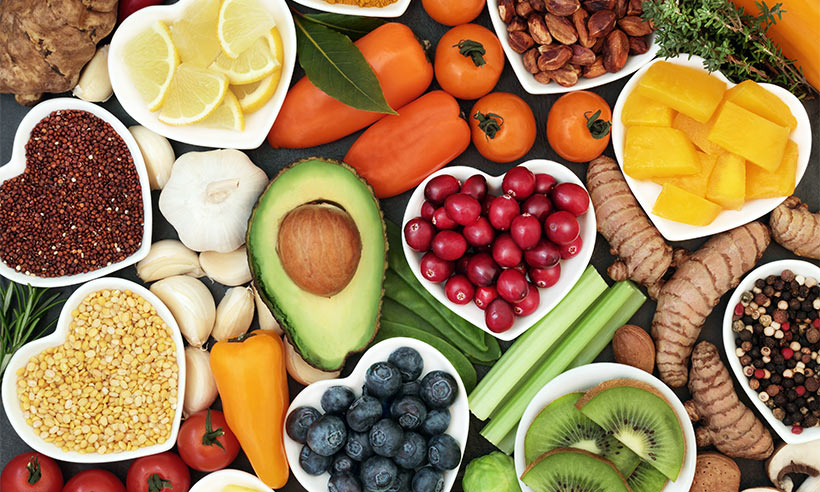
‘Veganism’. A word which is the catalyst for many debates and let’s face it, some pretty hilarious memes. However, as you have probably all noticed, the vegan lifestyle is becoming more and more popular and there seems to be an increased awareness across the board. Hopefully what follows will give you a brief insight into my life as a vegan and the effect it’s had on me, physically and mentally.
My Transition
I became vegan on the 11th of August, 2015, and I have to say it all happened pretty organically. My partner had been a vegetarian for approximately two years so my consumption of animal products had naturally reduced over that duration – but meat, eggs and dairy still made up a fair bit of my diet. She asked if I would be interested in watching a documentary called ‘Earthlings’ which looking back, was probably what started the transitioning process. I’m not going to go into the discussion of ethics – we’ve all seen the videos and anyone with an ounce of compassion can appreciate the moral justification behind veganism. Instead, I’d more like to focus on the health benefits of a plant-based diet, as this was a huge driving factor with me wanting to becoming one of those crazy extreme vegans. After viewing the documentary, I immediately dove into researching the health benefits of a vegan diet and that was “all she wrote”.
Current Diet
Now fast-forward almost 3 years and I couldn’t be happier. Now, I don’t want this article to turn into a solo episode of “This Is Your Life”, because to be honest I could talk about this stuff all day. Instead, I’ll choose three of the more significant diet-related points regarding my experience thus far with veganism.
- Micronutrients – the bottom line is that plant-based diets, when done correctly, will always result in eating a larger variety of foods. More experimentation takes part in the kitchen, more enjoyment is had with cooking, and as well as being very tasty, the meals are more colourful – and more colour means more nutrients! For example, when you’re meeting your protein requirements with foods such as beans, legumes, grains, nuts, seeds and vegetables rather than beef, chicken or fish, it’s pretty safe to say that you’re meeting many other nutrient requirements as well. Long-term, this sets you up for a far healthier and problem-free life, as you reduce your risk of chronic disease. For example, 28% of deaths in the year 2016 in Australia were a result of heart disease. A very significant factor of heart disease is atherosclerosis – the thickening and hardening of vessel walls – and a major cause of this is high cholesterol. But how many people know that dietary cholesterol solely comes from animal products, and that your liver produces enough cholesterol alone for normal bodily function? For me, the proof was in the pudding when, out of curiosity, I had a blood test in February of this year. My results were perfect, and my doctor was pretty impressed. Also, another fantastic change is that I haven’t been sick since becoming vegan, at all.
- ‘Feeling healthier’ – I have a very clear memory of 2014. I was in a ‘bulking’ phase and was consuming around 4000 calories each day. I have always strived to be the healthiest I can be, so even during this phase I was still eating plenty of vegetables and wholefoods. However, I still felt so crap. Every meal was a bigger struggle than leg day, and I was pretty lethargic the entire day. It was hard! Fast-forward to now and eating that same number of calories is entirely different. There is a noticeable difference with bloating and lethargy, and I’m generally more energetic. It’s hard to explain, but I honestly just feel healthier.
- Travelling and eating out – this is something a lot of vegan’s struggle with, but I’ve never really had a problem. Since being vegan, I’ve travelled to over 20 countries with my partner and we’ve never had an issue (thanks to wonderful apps such as HappyCow). Also, almost every restaurant has vegetarian options, and it’s never a difficult task to make these choices vegan-friendly – such as swapping out an egg or dairy product for a suitable alternative. What upsets me is hearing of complaints from the vegan community about restaurants NOT having enough vegan options. At the end of the day, veganism is in it’s infancy, and recognition on a menu in the form of a meal labelled as “Vegan” or “Vg” is a total win in my books. Recognition = awareness, and that’s the beautiful thing.
Current Training and Physical Changes
Training progress, body composition and my style of exercise have also all changed quite considerably. In addition to continuing compound strength training, I now incorporate a lot more gymnastics movements and bodyweight training into my regime and am thoroughly enjoying it. All of my personal bests for bench press, deadlifts and barbell squats have improved considerably, and I have learnt new skills such as handstands and ring muscle-ups. Could I have still achieved this as a meat eater? Probably. But, nothing feels better than going to the gym full of energy (which I didn’t always experience as a meat eater) and feeling like you can conquer anything. Also, it feels great to somewhat prove people wrong. Vegans cop a lot of flak and are always being targeted as ‘protein deficient’ or ‘malnourished’, but I’ve experienced more strength and muscle gain than ever before.
I would like to point out that I am not an expert on veganism and don’t claim to be. As I said, I strive to be well-educated and due to this point, my knowledge on diet and training is forever expanding. Also, my journey with veganism and the positive results I have experienced are just that – mine. Any diet can be done incorrectly, and individuals need to be well-educated with whatever it is they choose to consume.
Thanks so much for reading,
Matt
For information on training with Matt, contact us info@js-pt.com.au or PM us through our socials (Facebook, Instagram). For great content including vegan recipes and training videos, Matt can also be found on Facebook and Instagram.
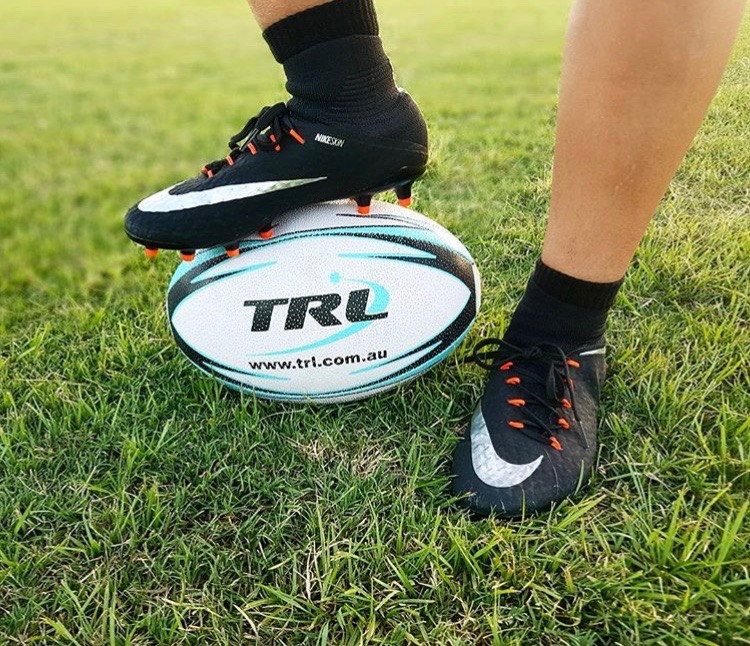 Whilst strength training sets the foundation for fitness, doing so in a gym or with a personal trainer is not the only physical activity you should do to stay healthy, but rather should be part of a wider active lifestyle. Making physical activity an easy part of your daily routine – like cycling on your commute to and from work, for example – or taking it up as a social activity – like weekend hikes or playing a social sport – should also be considered as part of this active lifestyle.
Whilst strength training sets the foundation for fitness, doing so in a gym or with a personal trainer is not the only physical activity you should do to stay healthy, but rather should be part of a wider active lifestyle. Making physical activity an easy part of your daily routine – like cycling on your commute to and from work, for example – or taking it up as a social activity – like weekend hikes or playing a social sport – should also be considered as part of this active lifestyle.
When it comes to social sport, combining fitness with socialising with friends or work colleagues has its benefits both physically and mentally. Social sport gives your training schedule variety and also promotes social health by spending time with friends and meeting new people.
On a personal note, I have been playing Touch Rugby League (TRL) for a number of years as my social sporting competition of choice. More recently, I’ve started working more closely with TRL through JS-PT on corporate health programs as an addition to group training sessions.
To speak more about the benefits of playing social sport and playing TRL in particular, we invited Chairman of TRL Tom Longworth to feature in this month’s JS-PT news:
Touch Rugby League (TRL) was founded in 2005 and has always been a social-sport at heart. Whilst we do offer very competitive and elite pathways, at the heart of our offering is providing teams the chance to exercise and get fit, but in a social context. TRL provides a great opportunity for people to meet others and has been an avenue through which thousands of Corporate teams have built upon team spirit and camaraderie.
Whilst physical health is important, so is mental health and a big part of that is maintaining healthy relationships with friends, family and work colleagues. In reality, we all spend more time with work colleagues than just about anyone so being able to relate to one another in a work context, and to have a strong bond (built on trust and respect) plays a key role in mental health.
TRL provides a great opportunity for people to engage, to develop a sense of trust, respect and teamwork on the field all whilst having fun and of course keeping fit. Strong relationships make for a better workplace.
With multiple locations across Brisbane (and Australia), it has always been straight forward finding competitions to enter, and also has helped me implement more cardiovascular training into my week! For more information on any of the above, please feel free to contact Tom directly by emailing tom@trl.com.au or by visiting the website.
Until next time,
James
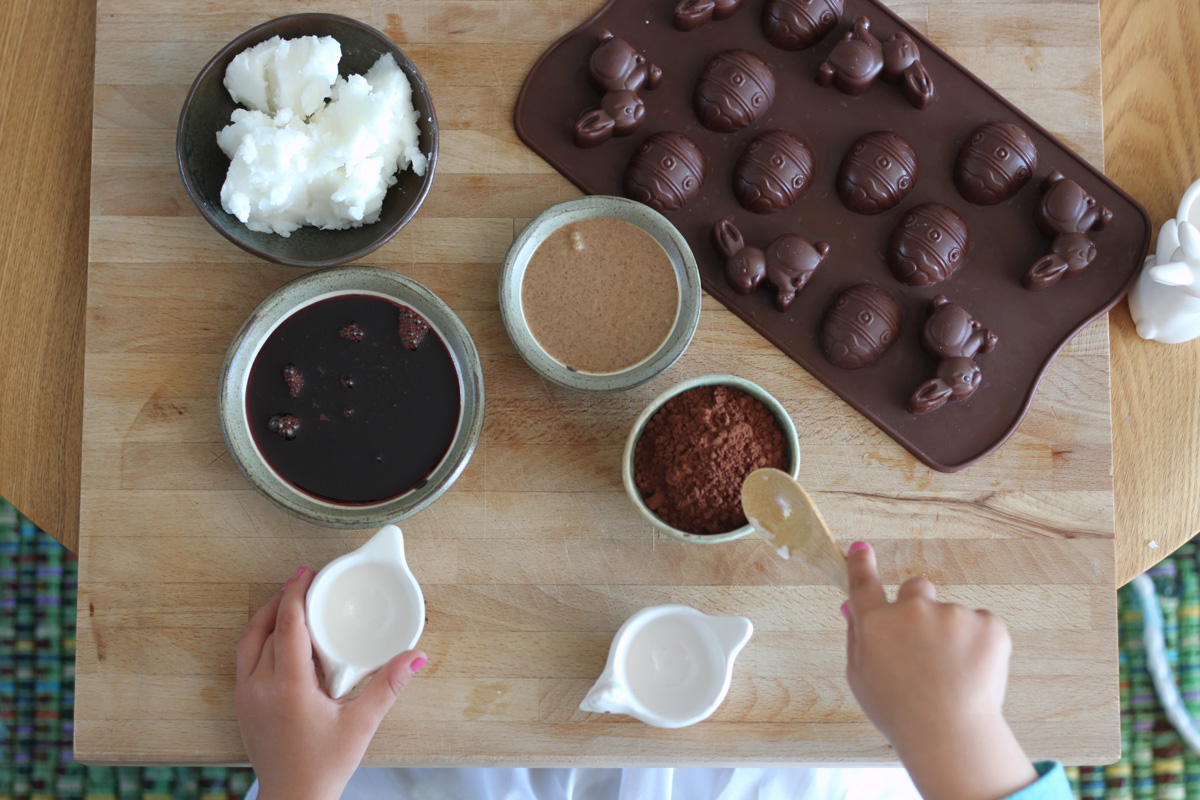
Following a recommendation from a JS-PT client, we thought we would share something different this month. Homemade vegan Easter eggs, from Jamie Oliver himself:
“For most of us, Easter has become a chocolate-filled, sugar-fuelled holiday, full of chocolate eggs, bunny-shaped treats and colourful Easter baskets.
For many parents, the prospect of endless sweet treats coming their children’s way can be daunting, so to help out, we’ve got a refined sugar-free, vegan chocolate egg for you to try.
These eggs are great fun to make with the kids, and while you’re at it, you could make some Easter baskets, which you can then fill with your homemade treats! You’ll need an egg mould, which you can buy online or at some large supermarkets – depending on the size of your mould, this recipe will make around six to eight small eggs or one bigger one.
To make 1 large egg or 6 to 8 smaller eggs, you’ll need 200g coconut oil, 6 tablespoons agave syrup and 120g raw cacao powder. You could also add 2 to 3 tablespoons of peanut butter.
Method:
1. Melt the oil in a bowl set over a pan of simmering water. Once melted, carefully transfer the bowl to your work surface.
2. Add the agave syrup (you could use maple syrup or even honey for a non-vegan version) to the melted coconut oil and mix together.
3. Add the cacao powder and stir until you have a smooth, liquid chocolate.
4. Reserving a little of the chocolate mixture, pour the rest into your moulds of choice, tilting the moulds so the mixture covers the surface.
5. Leave the moulds in your fridge or freezer for around 20 minutes, or until the chocolate has set.
6. Take the moulds out of the fridge and carefully remove the chocolate egg halves. Spoon in the peanut butter (if using) for a surprise filling.
7. Brush the rim of each mould with the leftover liquid chocolate, then stick the egg halves together.
8. Leave to set in the fridge for a further 10 minutes, then enjoy!
9. If you’re planning on buying traditional shop-bought chocolate eggs, it’s best to get good quality, dark chocolate with a high cacao content, as these will contain less sugar.”
https://www.jamieoliver.com/news-and-features/features/vegan-easter-eggs/













